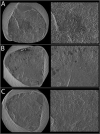Mechanical performance of original; yellowish and blueish ProFile instruments: isolating heat-treatment as a variable
- PMID: 36043568
- PMCID: PMC9645189
- DOI: 10.1590/0103-6440202204978
Mechanical performance of original; yellowish and blueish ProFile instruments: isolating heat-treatment as a variable
Abstract
The present study aimed to perform two different heat-treatments in an austenitic NiTi ProFile instrument and to compare the mechanical performance of original and heat-treated instruments. Heat treatment of ProFile (tip size 25 and 0.06 taper) instruments were carried out in a furnace in argon atmosphere using a heating rate of 10° C/min. After reaching the programmed temperatures of 450 ºC or 500 ºC the system remained at a constant temperature for 10 minutes; followed by cooling in water at room temperature. Afterwards; the three groups (n=30 per group) of instruments were compared regarding their cyclic fatigue (n=10 per group); bending (n=10 per group); and buckling resistance (n=10 per group). After cyclic fatigue tests; a scanning electron microscope was used to analyze the fracture surfaces and observe the fracture mode. Statistical analysis was performed using One-way ANOVA and Student-Newman-Keuls test; with an alpha type error set at 0.05. Yellowish and blueish coloration was observed in the ProFile instruments after 450 ºC or 500 ºC heat treatments; respectively. Conventional ProFile instruments showed the lower cyclic fatigue; and the higher bending and buckling resistance (P<0.05). In contrast; yellowish ProFile instruments (heat treated at 500° C) showed the higher cyclic fatigue; and the lower bending and buckling resistance (P>0.05). It can be concluded that the different heat treatments performed on ProFile instruments increased its cyclic fatigue resistance and improved the flexibility and buckling resistance.
O presente estudo teve como objetivo realizar dois tratamentos térmicos diferentes em instrumentos de NiTi austenítico ProFile e comparar o desempenho mecânico de instrumentos originais e tratados termicamente. O tratamento térmico dos instrumentos ProFile (tamanho de ponta 25 e conicidade 0.06) foi realizado em um forno em atmosfera de argônio usando uma taxa de aquecimento de 10°C/min. Após atingir as temperaturas programadas de 450 ºC ou 500 ºC o sistema permaneceu em temperatura constante por 10 minutos; seguido de resfriamento em água à temperatura ambiente. Em seguida; os três grupos de instrumentos (n=30 por grupo) foram comparados quanto à fadiga cíclica (n=10 por grupo); flexão (n=10 por grupo) e resistência à flambagem (n=10 por grupo). Após testes de fadiga cíclica; um microscópio eletrônico de varredura foi utilizado para analisar as superfícies de fratura e observar o modo de fratura. A análise estatística foi realizada por meio dos testes de One-way ANOVA e teste de Student-Newman-Keuls; com erro de tipo alfa fixado em 0.05. Coloração amarelada e azulada foi observada nos instrumentos ProFile após tratamentos térmicos a 450 ºC ou 500 ºC; respectivamente. Os instrumentos ProFile originais apresentaram menor fadiga cíclica e maior resistência à flexão e flambagem (P<0.05). Em contraste; os instrumentos ProFile azulados (tratados termicamente a 500°C) apresentaram maior fadiga cíclica e menor resistência à flexão e flambagem (P>0.05). Pode-se concluir que os diferentes tratamentos térmicos realizados nos instrumentos ProFile aumentaram sua resistência à fadiga cíclica e melhoraram a flexibilidade e resistência à flambagem.
Figures


References
-
- Sousa-Neto MD, Silva-Sousa YC, Mazzi-Chaves JF, Carvalho KKT, Barbosa AFS, Versiani MA, et al. Root canal preparation using micro-computed tomography analysis: a literature review. Braz Oral Res. 2018;18:e66–e66. - PubMed
-
- van der Vyver PJ, Paleker F, Vorster M, de Wet FA. Root canal shaping using Nickel Titanium; M-Wire; and Gold Wire: A micro-computed tomographic comparative study of One Shape; ProTaper Next; and WaveOne Gold instruments in maxillary first molars. J Endod. 2019;45:62–67. - PubMed
-
- Bhuva B, Ikram O. Complications in endodontics. Prim Dent J. 2020;9:52–58. - PubMed
-
- Molander A, Caplan D, Bergenholtz G, Reit C. Improved quality of root fillings provided by general dental practitioners educated in nickel-titanium rotary instrumentation. Int Endod J. 2007;40:254–260. - PubMed
MeSH terms
Substances
LinkOut - more resources
Full Text Sources

